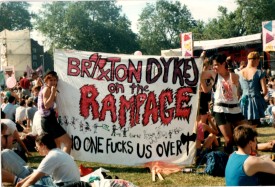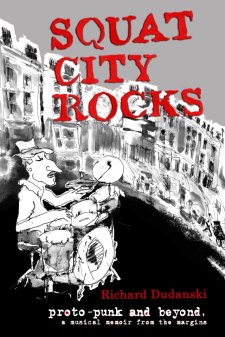“Before there were queer activists, before there were Riot Grrls, there were the Rebel Dykes of London. They were young, they were feminists, they were anarchists, they were punks. They lived together in squats and at Peace Camps. They went to political demos every Saturday, they set up squatted creches and bookshops, feminist newspapers and magazines. They had bands like Poison Girls, Mouth Almighty, The Darlings and Well Oiled Sisters… This documentary film is being made because the history of the London Rebel Dykes of the 1980s is in danger of being forgotten. Rebel dykes created their own world, made their own rules, and refused to be ignored. So we can’t let history tidy them away.”
On 14 November Ladyfest Manchester will feature meetings, workshops and music AND the launch of the trailer for an exciting new documentary about those hell-raising 1980s Rebel Dykes of London. Unfortunately the day-long Ladyfest event is already sold out, but if you’re already going you might be interested in our presentation at 6.30pm.
Producer Siobhan Fahey will do a presentation with music, images and oral history. I’ll be reading from a story or two about my rebel dyke days, along with fellow writer Maj Ikle. Music on stage includes Lesley Woods (former Au Pairs singer and guitarist) and the film’s co-director Harri Shanahan will be playing with her band ILL. For the full line-up see the Ladyfest Manchester website or click on the schedule on the right.
For those who are interested but haven’t got a ticket to Ladyfest, Siobhan will do a similar presentation in London on 5 December at the Speak Up! Speak Out! queer history conference.

Ye olde Amstrad
If the queer riot graphic at the top seems familiar to a few of you, I included it in my 2013 post, One Funeral and a Playlist. It’s based on the front page of a ‘zine called Feminaxe, the result of a hectic all-night lay-out session in 1987. We needed to get it to the printer so we’d have the paper for a Clause 28 march in Manchester. We did most of the typesetting on an Amstrad but these were the days before full-on computer design. Quark was only a creamy cheese our homesick German friends talked about, not the ubiquitous graphics application later replaced by InDesign. So lay-out involved cutting stuff up, laboriously scratching at those incendiary headlines in Letraset, spray-mounting and moving pieces of paper about, having a laugh but also getting grumpy with lack of sleep. And despite our greatest efforts, sticky bits of paper would inevitably be left stuck to the floor.
Those Clash-inspired lyrics with a queer twist came from a song by the Sluts From Outer Space, inspired by a fight with the cops on Downing Street during a Clause 28 march in 1987. Afterwards a few of us ended up revising “White Riot” as we made our way home. Another rewrite we perpetrated was “The Dykes of Brixton”: “You can nick us you can evict us but you have to answer to oh oh the Dykes of Brixton”. Well, I really did love the Clash, and still do.

Three out of seven or eight Sluts. Briefly we were called Rebel Sleaze but that name never stuck

At Gay Pride 1988 in Jubilee Gardens
Beyond the parodies, our own songs included the (anti)bicentennial in Australia, more stuff about Clause 28, Restart interviews (forerunner to the benefit sanctions regime). And sex of course, with our finale number “Wild, Hot and Wet”.
Our biggest gig took place at East London Polytechnic in Stratford, where we supported punky-reggae band Culture Shock. As I watched them, I was very impressed that the bass player played with three fingers. Oh yes, did I forget to mention that I played bass?
I recently saw that Culture Shock has been gigging again. Not so for the Sluts, I’m afraid. We split sometime in 1989 due to the proverbial personal and musical differences, or perhaps it was because some of us moved out of London. Whatever… We did have a brief reunion for a couple of numbers at a 1990 gig by Latin/Spanish band Los Lasses, which involved our drummer Jill.
There are no YouTube videos of the Sluts, and our recordings are just on cassette – I have one from a very chaotic rehearsal. It is currently being digitised but I expect to shudder when I hear it again! But I do have a photo of us performing in front of the wonderful banner we used for marches and gigs.
Unfortunately, the banner no longer exists. It was cut in half when someone at the squat where Feminaxe had an ‘office’ (an empty housing benefit office next to what is now the Hootenanny pub) used it for a curtain when she ran a rave. If I recall (and I could be wrong so many years after) it was a paid event. I regarded this as our own countercultural version of the backlash and creeping conservatism of the 1990s – OK now to use communal space in squats to make money, was it? So we had our disagreements; it wasn’t all sisterhood and sweetness. But maybe we’re getting out of the time period covered in the film…
Now, a word about my writing. Though I was reading a lot of speculative fiction, most of my own work at the time was non-fiction, polemic and straight-up realism. But in retrospect, I believe that the name of our band hinted at the more fantastical turn that my writing would take in the future…



 hts returned to this book several times over the holiday period, when a squat on Charing Cross Road was set up to feed the homeless – and it was promptly evicted. Much of the creative activity Dudanski describes had its basis in squatting – people could live cheaply and communally in big old houses, they were able to make space for studios and rehearsals and gigs. He doesn’t glamourise life in these communities; there’s no shying away from showing violence from police and unsympathetic neighbours, as well as tensions within households. He pulls no punches about the hard work it often takes to turn a derelict property into a home.
hts returned to this book several times over the holiday period, when a squat on Charing Cross Road was set up to feed the homeless – and it was promptly evicted. Much of the creative activity Dudanski describes had its basis in squatting – people could live cheaply and communally in big old houses, they were able to make space for studios and rehearsals and gigs. He doesn’t glamourise life in these communities; there’s no shying away from showing violence from police and unsympathetic neighbours, as well as tensions within households. He pulls no punches about the hard work it often takes to turn a derelict property into a home.

